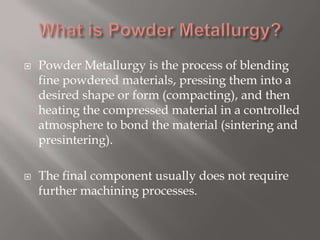
Powder metallurgy
- 1. Powder Metallurgy is the process of blending fine powdered materials, pressing them into a desired shape or form (compacting), and then heating the compressed material in a controlled atmosphere to bond the material (sintering and presintering). The final component usually does not require further machining processes.
- 2. There are 2 main requirements of any material for it to be processed by powder metallurgy: 1. The metal in the powder form must be able to respond to solid phase welding. 2. The metal powder must be capable of sufficiently close packing under pressure to permit welding to take place and In case of alloys, be capable of being sufficiently and intimately mixed.
- 3. The early Egyptians made metal products by application of powder metallurgy principles as early as 3000 B.C. In 1829, an Englishman made ductile platinum by cold pressing and sintering. In 1870, Auervan Welsbach prepared osmium filament by using powder metallurgy. In 1916,the first commercial tungsten wire was produced by this technique. Powder metallurgy was used in Germany for producing tungsten carbide tool tips after the first world war. Powder metallurgy became widely recognised after 1945 and today, parts which cannot be formed using other processes are made using this process.
- 4. Porous products like bearings and filters. Refractory parts made from tungsten and molybdenum used in electric bulbs and radio valves, x ray tubes ,etc Products of complex shapes like gears which need complex machining when made by other processes. Automotive components like electrical contacts , crankshafts,camshafts, piston rings , brackets, brake linings, connecting rods ,etc. Products from materials that are very difficult to machine like tungsten carbide , etc Components are gauges , wire drawing dies, wire guides , deep drawing, stamping and blanking tools stone hammers, rock drilling bits. Tungsten parts used in high temperature operations like nozzles for rockets and missiles. Grinding wheels, clocks and other timing devices ,
- 5. The performance of metal powders during processing and the properties of the product are highly dependent on the characteristics of the metal powders that are used. The most important characteristics of metal powders are : 1. Purity 2. Chemical composition 3. Particle size 4. Particle shape 5. Size distribution 6. Particle microstructure 7. Apparent Density 8. Flow rate
- 10. The parts made by powder metallurgy are usually brittle and difficult to handle before they are sintered. To overcome this, the compacted parts are first heated at a temperature lower than the actual sintering operation temperature. This gives the parts sufficient hardness and strength to be handled and machined as required. Presintering also removes lubricants and binders added to the powders earlier.
- 11. After being compressed into the required shape, the required components are sintered. Sintering is done to achieve the maximum possible hardness and strength needed in the final product. Sintering is usually done at 70- 80% of the metal’s melting temperature in an inert atmosphere of hydrogen, ammonia or other hydrocarbons. The sintering time varies from thirty minutes to several hours depending on the metal used. Sintering causes the bonding of the solid particles within the component. Once cooled, the powder bonds to form a solid piece.
- 13. Metal powders are contained in an enclosure e.g. a rubber membrane or a metallic can that is subjected to isostatic,(that is uniform in all directions,) external pressure. As the pressure is isostatic, the as-pressed component is of uniform density. This will then be sintered in a suitable atmosphere to yield the required product. Normally this technique is only used for semi-fabricated products such as bars, billets, sheet, and roughly shaped components, all of which require considerable secondary operations to produce the final, accurately dimensioned component. Again, at economical working pressures, products are not fully dense and usually need additional working such as hot extrusion, hot rolling or forging to fully densify the material.
- 15. 1. Graphite: Refractory graphite, Control rods for nuclear reactors. 2. Ferrites: Parts like permanent magnets, computer memories ,electronic components 3. Ceramics : Tubes, tiles, nozzles and linings. 4. Metal powders : High speed tool steels, superalloys, stainless steel, titanium alloys , berylium , etc.
- 16. Uniform Density of Compacted objects High strength and good handling properties of compacted body Reduction in internal stresses Possibility of combining powders without additional binding compounds Low tool costs Low material and finishing costs
- 17. Dimensional control of the compacted objects is a little less precise than other methods. The surfaces of pressed components are not very smooth. This process is generally a low production process and is thus used rarely. The flexible molds used in CIP dies usually have a short life.
- 18. The dimensional accuracy and the desired surface finish can be maintained. Cleaner and quieter operation. Longer life of components due to enhanced microstructure and lack of defects. High production rates even with complex shapes. Highly qualified labor not required for operation. 99.9% utilization of material, negligible amount of scrap. Certain mixtures or alloys can be obtained through this process. (for eg. It is very difficult to produce lead and copper alloys in the liquid form. However, the problem of immiscibility can be averted by mixing both elements in the powder form and then shaping it by powder metallurgy.
- 19. It is difficult to produce certain shapes which require the flow of metal which is not possible in powder form. The parts made by powder metallurgy may be brittle if not sintered properly. The dies for this method are quite expensive. The size of the products that can be manufactured is limited due to the high costs of large dies and material handling. Powder metallurgy is un-economical for small scale production. Some metals are difficult or impossible to compress due to their tendency of sticking to the walls of the die under high pressures. Disadvantages of Powder metallurgy over other processes